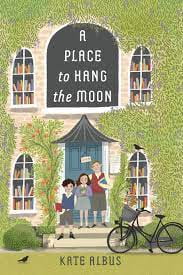 When A Place to Hang the Moon begins it is 1940 and Anna (9), Edmund (11) and William (12) find themselves orphaned and alone in London. After the death of their grandmother, the children discover she has left no provision for their guardianship in her will. What will happen to them now? Could the mass wartime evacuation of children from London be the answer? Maybe. Their solicitor develops a “preposterous plan.” He suggests the children go to the countryside. Perhaps there, they will find a forever family for themselves. The solicitor helps the children join the local schoolchildren who are being evacuated to countryside for the duration of the war. The hope – for the solicitor AND the children – is to be placed in a temporary home that will last forever if all three of the childre agree on the choice.
When A Place to Hang the Moon begins it is 1940 and Anna (9), Edmund (11) and William (12) find themselves orphaned and alone in London. After the death of their grandmother, the children discover she has left no provision for their guardianship in her will. What will happen to them now? Could the mass wartime evacuation of children from London be the answer? Maybe. Their solicitor develops a “preposterous plan.” He suggests the children go to the countryside. Perhaps there, they will find a forever family for themselves. The solicitor helps the children join the local schoolchildren who are being evacuated to countryside for the duration of the war. The hope – for the solicitor AND the children – is to be placed in a temporary home that will last forever if all three of the childre agree on the choice.
The children are determined to stay together, but this proves challenging. Not many homes are willing to billet three new children. First the siblings have to deal with the cruel tricks and bullying from their foster brothers. Next they have to survive the cold realities of poverty, outdoor toilets and gnawing constant hunger. Always they have to satisfy the head teacher, who did not want them in the first place, and who finds Edmund to be a real trial.
The only comfort in their terrible ordeal is the small lending library and the librarian, Nora Müller. Every time they arrive at the library there is a warm fire, a kind smile, an extra cookie and just the right set of books. Anna thinks Mrs. Müller would be an excellent choice for their “forever home”, but her husband is German. No one knows where he is currently, and some in the village stay away from her and believe she is most unsuitable as a home for children. The boys think she is a good choice, but time will tell.
Time does tell. Eventually it becomes clear that something must be done if they are to survive … and it is.
A Place to Hang the Moon is an unforgettable book. It is impossible to make it last just as Anna found with her one book – one page leads to the next, and the next and the next, until, before you know it, you’ve reached the very satisfying end.
In the Author’s Note, Kate Albus tells us that her Edmund is named for the first Edmund she met when she read The Lion, the Witch and the Wardrobe. She says that is where the idea for this book began. The similarities shine. What a wonderful story. What a wonderful book.
Happy Reading!📚
If you find yourself interested in reading more about the children involved in the evacuation please look for The War That Saved My Life.